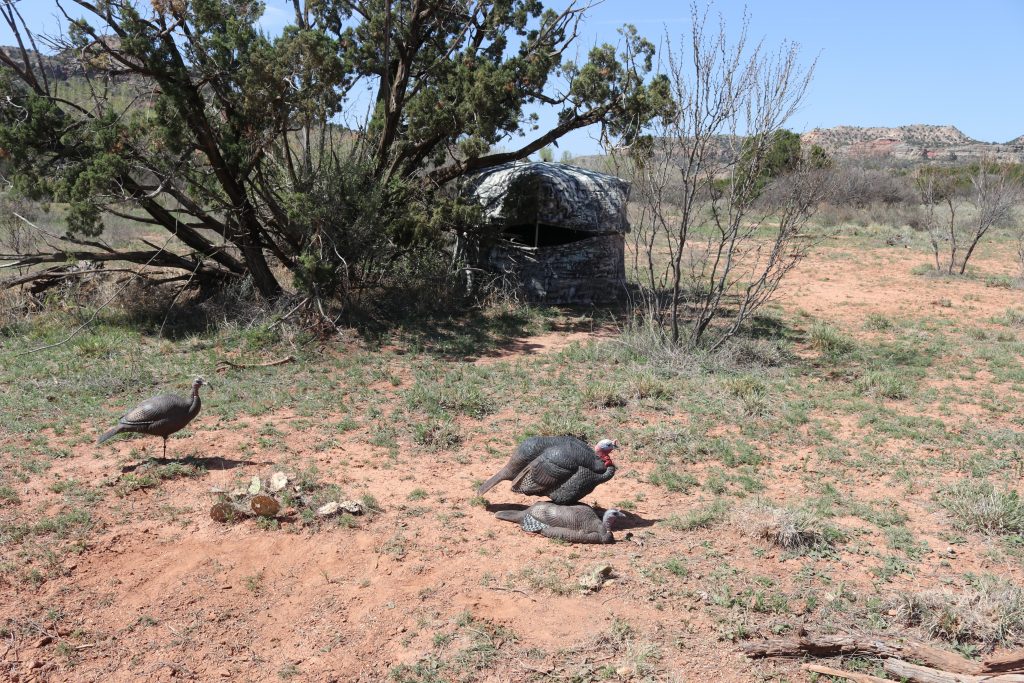Shooter’s Bench: Turkey Bowhunting
My first wild turkey was a Rio Grande gobbler from central Texas. It was the spring of 1986, I was a skinny teenager and I thought I knew everything. I did not. I’ve endured many hard lessons chasing turkeys since then, but I eventually created a formula for consistent success. Here are four rules I wish someone would have told me.
RULE NO. 1: SETUP IS KEY

Odds of success with a bow are much higher from a well-positioned blind than hiding in available cover. Look for sign like pitchfork-shaped tracks, spent feathers and droppings to decide where to set the blind. A rancher or landowner can save you time by telling you where they routinely see turkeys. Choose a roomy pop-up blind and secure it at all corners, preferably set in the shade. Set the blind so the primary shooting window faces north or south. Close all the other windows. If positioned to the east or west, the rising or setting sun can reflect off a shiny bow or hand, spooking a nearby turkey. Clear out leaves and sticks from inside the blind and lay down a blanket to muffle sound. I often take my shoes off and sit in sock feet, then shoot from my knees.
RULE NO. 2: CALLING AND PATIENCE
Don’t be intimidated by pros and think you need expert calling skills to kill a gobbler. Start with a simple box call and learn how to make realistic yelps. If a blind is in a well-scouted location, minimal calling can lure a curious gobbler into range. Many times, gobblers do not vocally respond, instead approaching the sound of your call quietly. Listen for the sound of his wings dragging the ground, strutting. Be patient! If I’m confident my blind is in a good location, I sit all day. Pack snacks, water and books to pass the time. When I hunt all day, I call about every half hour in case a gobbler is nearby.
RULE NO. 3: SELECT THE RIGHT RIG
Choose a smooth-drawing bow with minimal accessories. I like short axle rigs, 29-34-inches, with basic add-ons. Rig the bow with a short stabilizer so it won’t bump the front of the blind. Add a QAD drop-away rest and a single pin HHA Optimizer sight with a bright green fiber optic pin. I set the one pin for 20 yards and practice for shots from 10-25 yards. A ¼-inch peep sight allows plenty of light to reach my eye in a dark blind. Don’t let the draw weight bullies convince you that you need a heavy draw weight. I routinely kill turkeys and deer with bows that pull 55-60 pounds. Even less will work at short distances. The ability to draw the bow smoothly with minimal movement and hold it steady while you aim is more important than macho poundage. My turkey setup last year was a Mathews Lift X 29.5 bow set at 55 pounds at my 28-inch draw length.
RULE NO. 4: KEEP SHOTS CLOSE
Set decoys about 8-10 yards from the blind. My go-to setup is a bedded hen with a half strutting jake and an upright hen. Even if the gobbler hangs up beyond the decoy spread, he’s usually under 20 yards. I prefer head/neck shots instead of body shots. This requires some extra thought to your arrow and broadhead. I’ve had good luck with 100 grain Magnus Bullhead broadheads on the end of stiff carbon shafts fletched with three, 4-inch feathers. My finished arrow weight including the steel insert and broadhead is between 450-500 grains, depending on shaft size.
These are the basics. Why didn’t someone tell me?
